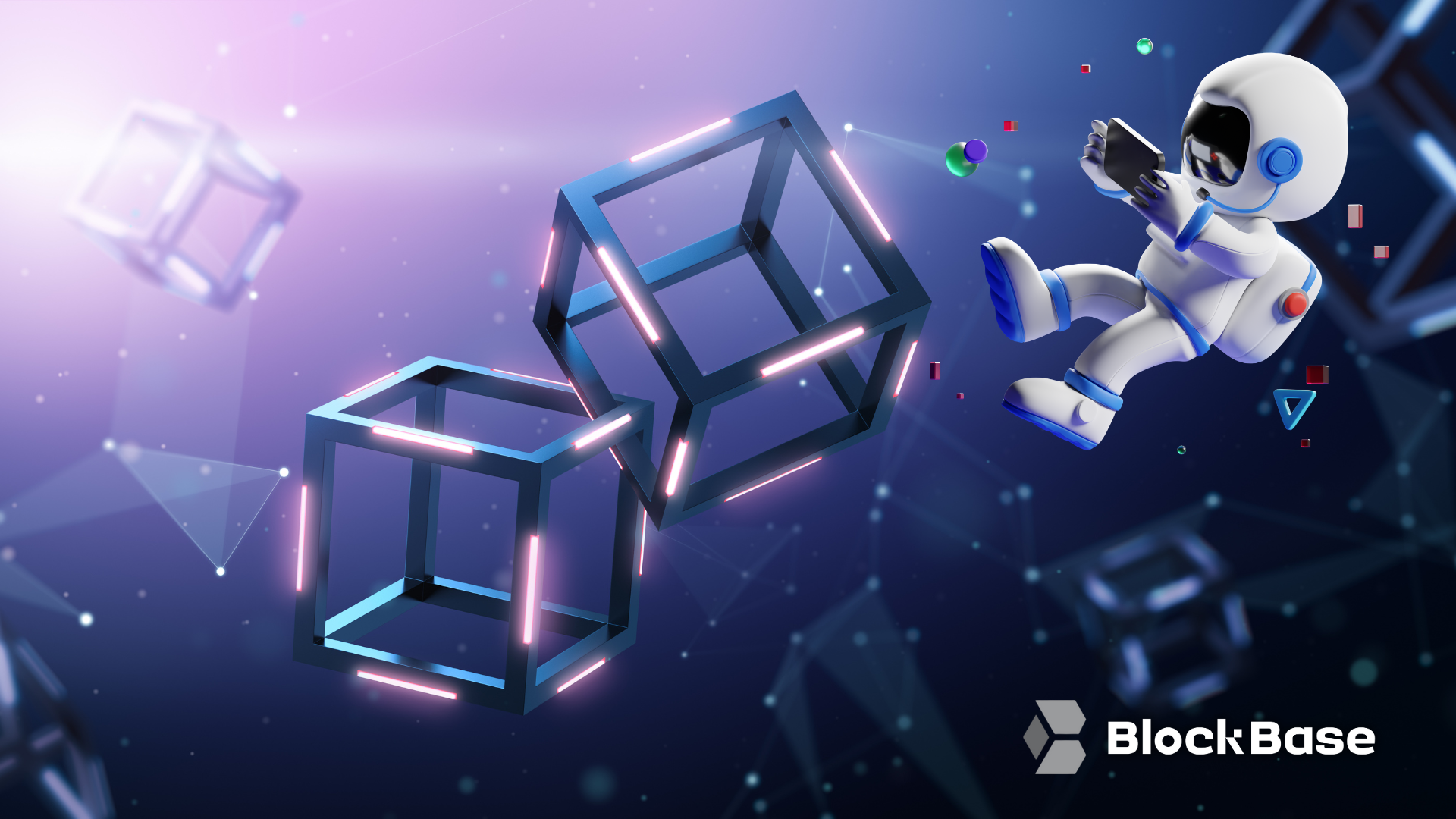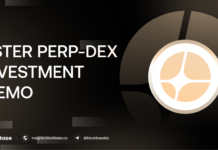GameFi (Gaming + Finance) is a term that has emerged since 2021. GameFi describes blockchain games with the primary purpose of playing games to earn money, providing economic incentives to players. Typically, players can earn cryptocurrency and NFT rewards by completing missions, battling other players, and achieving different levels in the game.
Unlike traditional video games, most blockchain games allow players to transfer in-game items out of the game world. This enables players to trade their items on the NFT market and sell cryptocurrency rewards on exchanges.
Traditional Gaming Market
According to Mordor Intelligence, the global gaming industry is projected to reach a total revenue value of nearly $246 billion in 2023 and is expected to surpass $376 billion by 2025. The report indicates that mobile gaming has been a significant driving force behind the industry’s growth, with over 2.5 billion gamers worldwide playing on handheld devices. The report suggests that revenue from in-game transactions is expected to account for nearly 80% of total gaming revenue (such as purchasing publisher items to overcome difficult levels).
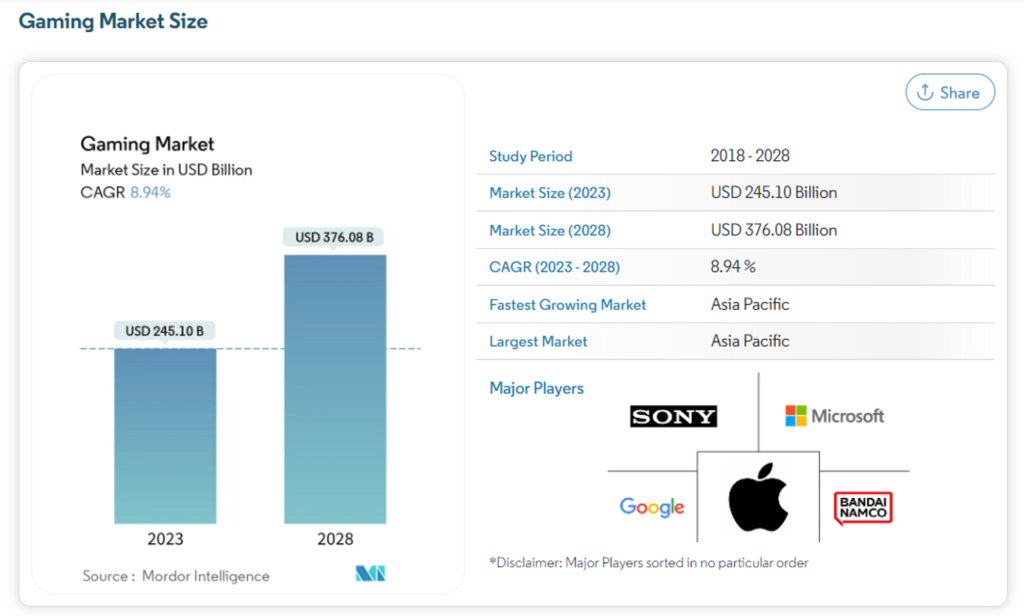
Furthermore, the market share of the traditional gaming industry is also noticeably fragmented, with 47% of gamers coming from the Asia region and 27% from the North America region.

By 2027, the Chinese gaming market alone is expected to have nearly 750 million gamers. Despite the country’s declining population, the number of gamers is increasing. Nearly one-third (31%) of these gamers are spending on mobile games. Chinese companies account for 47% of global mobile gaming revenue, including the domestic market.

However, most gamers are unable to take their in-game items out of the game and directly sell them to other players. This limits content creativity and sometimes leads to wastefulness, as some players have invested a significant amount of money into in-game items. Blockchain, on the other hand, is considered the key to allowing players to confirm ownership rights and transparently trade in-game items. This opens up a new economy that enables cross-game transfers, fostering innovation and reducing waste.
The Rise of GameFi
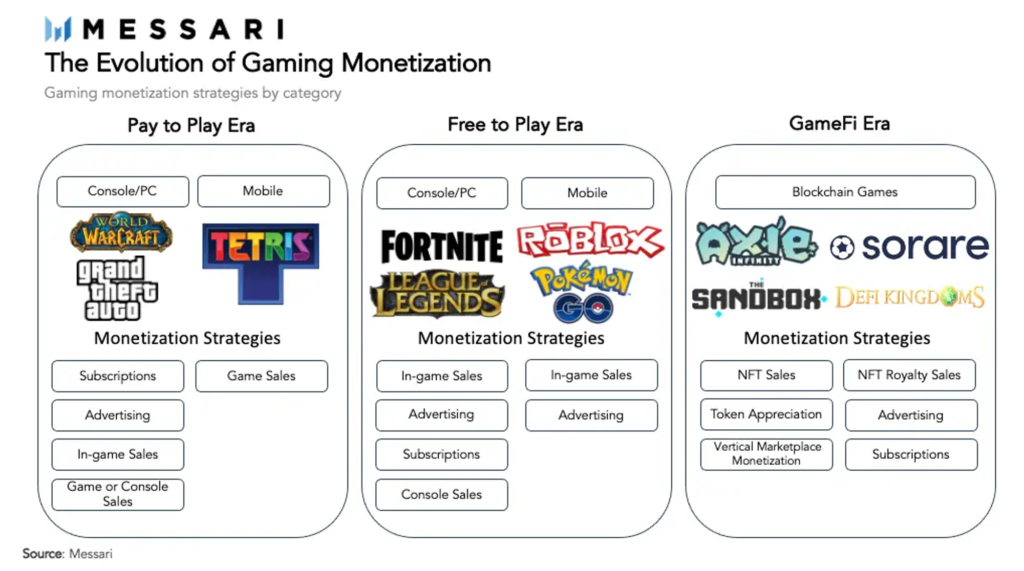
GameFi has undergone various stages of development, starting with traditional game models primarily based on in-app purchases. During this time, game studios emerged as powerful entities, dominating the industry. Game updates and releases were driven by the mindset and strategies of the publishers, with limited changes. This often resulted in imbalances and occasional glitches, leading to frustrating experiences for players who had invested significant amounts of money in in-game items. It also meant that players had to wait quite a while for bug fixes to be delivered. Additionally, early versions of games often required players to pay upfront to access the game, creating a barrier for some users that they have to “Pay-to-Play”.
In order to eliminate these barriers for gamers, the next generation of games allowed players to experience games with nearly zero cost. This led to a surge in the number of players and was accompanied by remarkable advancements in graphics and gameplay. Community interaction and engagement within games were greatly enhanced through the introduction of new features such as guilds, PvP (Player versus Player), and campaigns.
However, game publishers still held significant power during this phase. By owning the intellectual property of in-game characters, making decisions on costume releases, altering game meta, or continuously introducing rare in-game items, some players felt that their spending was unfair. Furthermore, as new projects emerged, many others failed. It was not uncommon for players to invest a substantial amount of money only to receive notifications that the game would no longer be developed or supported. This was particularly prevalent in the game market where technology and design are constantly evolving.
In the years 2020-2021, humanity experienced a major pandemic, COVID-19, which had a profound impact on the global economy. During the pandemic, the economy faced significant isolation and stagnation. Non-cash payment methods and technology-driven connectivity became more prominent, with a strong growth in user adoption of online video streaming platforms. At that time, Axie Infinity emerged as a solution that allowed users to earn money by playing the game. In the Philippines market, numerous guilds with hundreds of thousands of players were formed. Philippine government even had to intervene and impose taxes on Axie Infinity players’ earnings.
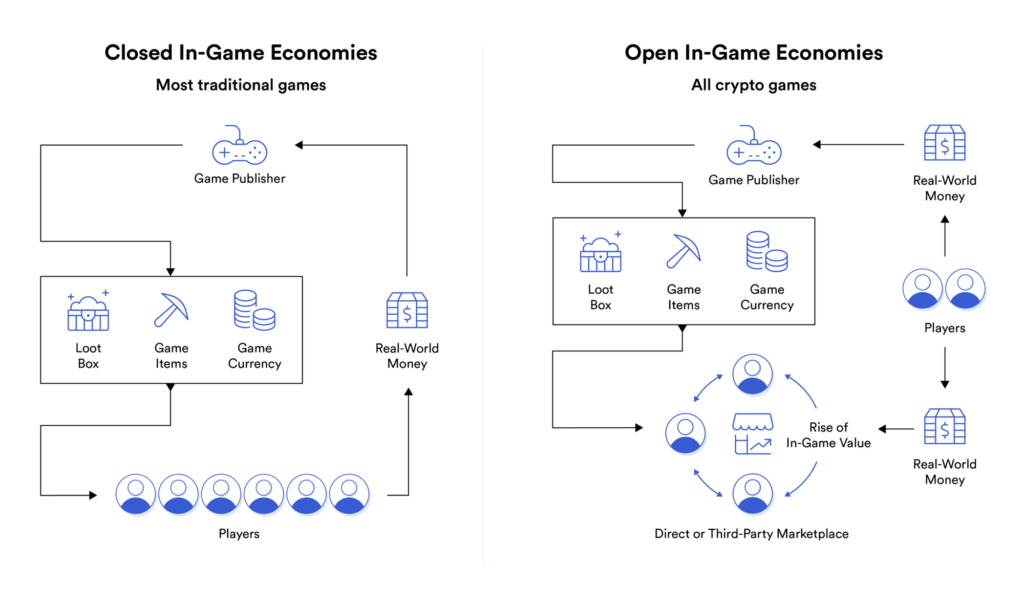
So why are Axie and other blockchain games considered to open a new era for the gaming industry? There are several reasons for this:
- Economic Incentives: Historically, the majority of in-game economies did not reflect real-world value through tangible assets. It was normal for gamers to spend money on games without receiving any tangible value in return, and the cash flow was often one-way, benefiting only the game publishers. Additionally, intellectual resources within games, such as creative puzzles or Minecraft, did not benefit content creators.
- Ownership: By utilizing Non-fungible Tokens (NFTs), users now have true ownership of their in-game items. Since most NFTs are built on common standards like ERC-721, ERC-1155, etc., users can track various parameters surrounding their items, such as rarity (how many people hold the item), attributes (determining rarity), the quantity in circulation, or even the most active trading markets. This provides players with significant informational advantages.
- Opening a New Economy: The use of NFTs to back in-game items has made these items tradeable, opening up countless new opportunities. From basic models like NFT Marketplaces to more complex ones like lending/borrowing NFTs or even the ability to use NFTs across different games, this increases the utility of in-game items and opens up secondary markets such as collateralization and credit, enhancing the interactivity between different games. This is something traditional game economies cannot achieve.
- Lowering Entry Barriers: GameFi is increasingly welcoming new players with free-to-play mechanisms, and the use of social logins is becoming more popular. Users only need an account on commonly used social media platforms to participate in the gaming experience. This presents a significant opportunity for service platforms related to NFT/crypto wallets, as the demand for such services will increase with the number of players engaging in games.
- Creating New Business Models: While traditional games are often limited by geographical and infrastructural constraints, GameFi introduces various new business models:
- Guilds: Guilds operate more easily, with a unified currency that facilitates item exchange. The business model for guilds in GameFi is more apparent compared to traditional game guilds.
- Data Services: Player data is essential for developers to continuously improve their products in line with overall trends. With metrics stored on the blockchain, observing both the general gameplay meta (the most popular NFTs) and the behavior of different speculative components (token traders/holders) becomes intriguing. GameFi data analysts provide high-quality data for studios and players.
- On-chain Advertising: Advertising has long been a revenue channel for studios, but some games allow users to customize individual NFT images or display them in virtual space within the metaverse for advertising purposes. This is a promising field for such activities.
- GameFi Aggregators: Game blockchain requires a certain level of basic knowledge to participate, and due to financial involvement and the need to spend money in advance, the demand for research and economic estimation services specific to GameFi is higher compared to traditional free-to-play games. This creates demand for service providers specializing in researching and estimating the economic aspects of GameFi.
- Publishing platform: As the market witnessed an increasing number of games emerging that are connected to user assets, having a reputable publishing platform with strong evaluation capabilities is always the top priority. Currently, the majority of publishing platforms are launchpads or IDO platforms.
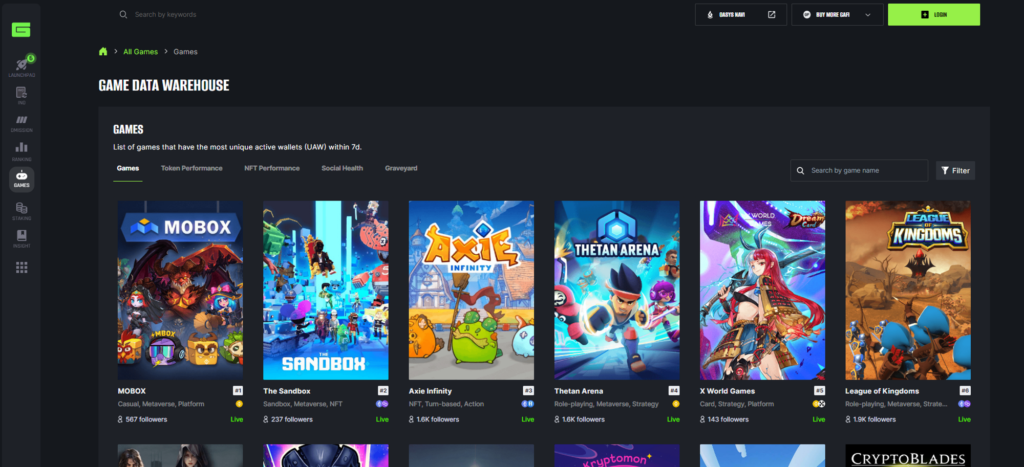
Challenges
Although the future of GameFi still holds considerable growth potential, there are lingering challenges that require some “unicorns” to address:
- Gameplay/Game-nomics Balance: This is an extremely difficult task even in traditional games, and it becomes even more challenging when incorporating an economic model into the game. We have seen many games constantly releasing updates within just one week to try to rebalance the in-game economy. In GameFi, adjusting rewards to balance the game can face stronger opposition from players compared to traditional games.
- Mobile Integration of GameFi: Currently, GameFi is predominantly focused on PC platforms, with limited services catering to the mobile segment. Mobile browser interfaces often encounter loading errors, hindering mass adoption. In the future, we can expect an increasing number of native apps on popular operating systems like Android and iOS.
- Security: Since GameFi involves smart contracts and some games are built on their own infrastructure (off-chain), security is always a top concern. We should not forget the Axie Infinity incident, where a hack resulted in a loss of up to $600 million, along with numerous other major and minor hacking incidents.
- Infrastructure: GameFi generates a significant volume of transactions and attracts a large player base, thus demanding a robust infrastructure. For an off-chain game to run smoothly with 100,000 to 200,000 players, the blockchain must ensure low gas fees, a sufficiently fast network, and minimal latency. In the case of on-chain games, a recent term, the requirements become even more stringent. The game project Sunflowers Land, for example, caused congestion on the Polygon network within just 10 days of its launch.
Conclusion

With the current blockchain gaming market valued at $5.67 billion, we can see that there is still a significant room for industry development. There are several factors supporting this industry.
Firstly, there is an increasing interest in gaming among people. The rise of esports and the livestreaming industry in the past decade have reinforced the idea that gaming is not just entertainment but also a legitimate profession. Popular games are now competing with traditional sports to attract participants, an idea that seemed unimaginable just two decades ago. Particularly, blockchain gaming has garnered significant attention, with investment in this sector being among the highest compared to other NFT-related industries, highlighting a shift in risk investment focus as investors begin to seize opportunities in this field.
The second favorable factor is the continued adoption of cryptocurrencies. GameFi is among the sectors that provide the best entry points for users to access cryptocurrencies. Combined with DeFi, NFTs, Web3, and other products, increasing overall activity in the blockchain industry in the coming years becomes more feasible.
Predictions are speculative, but exciting activities and rapid development are currently taking place. The opportunity to own assets of your own, earn money from games, and connect with a larger recognized community are attractive features in this relatively new blockchain gaming industry.


